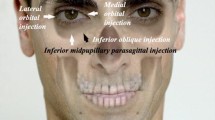Summary
The bulk drainage of aqueous humour into the general circulation and into the orbital tissues was studied with 131I-labelled albumin and red dextran (molecular weight 40,000) in rabbits with and without cyclodilaysis.
In animals at a normal intraocular pressure of about 20 mm Hg and without an artificial cleft between the anterior chamber and the suprachoroid the rate of aqueous bulk flow into the general circulation was 3.99 ± 0.55 μl/min. There seemed to be some outflow also through other routes ending up in the episcleral tissues in the limbus region but less than 0.11 ± 0.02 μl/min was drained in that way.
Even in dead eyes maintained at an intraocular pressure of 14 mm Hg only negligible quantities of labelled anterior chamber fluid passed into the tissues with bulk flow.
In acute experiments in living animals, after a cleft had been opened between the anterior chamber and the suprachoroid without damaging the sclera, the rate of aqueous production was 5.64 ± 0.65 μl/min. On an average 54% of the aqueous humour was drained into the suprachoroid from where great amounts penetrated the sclera in part by way of perivascular spaces in part directly through the scleral substance. Before the cleft was produced the facility of outflow was 0.237 ± 0.038 μl/min per mm Hg, afterwards it was on an average 0.505 ± 0.092 μl/min per mm Hg higher.
Résumé
Le „bulk” drainage d'humeur aqueuse dans la circulation générale et dans les tissues orbitaux était étudié avec d'albumine marquée par 131I et de dextrane rouge (poids moléculaire 40,000) chez des lapins avec et sans cyclodialyse. Chez des animaux avec une pression intraoculaire normale d'environ 20 mm Hg et sans une communication artificielle entre la chambre antérieure et la suprachoroïde la vitesse du „bulk” flux aqueux dans la circulation générale était 3.99 ± 0.55 μl/min. Il semblait avoir quelque flux aussi par d'autres voies directement dans le tissue épiscléral dans la région limbale; mais moins que 0.11 ± 0.02 μl/min. était drainé ainsi.
Même dans des yeux morts maintenus sous une pression intraoculaire de 14 mm Hg seulement des quantités insignifiantes d'humeur aqueuse marquée filtraient de la chambre antérieure dans le tissu épiscléral comme „bulk” flux. Dans des expériences aiguëes avec des animaux vivants, après avoir fait une ouverture entre la chambre antérieure et la suprachoroïde sans blesser la sclérotique, le débit de l'humeur aqueuse était 5.64 ± 0.65 μl/min. En moyenne 54% de l'humeur aqueuse étaient drainés dans la suprachoroïde, et de là partiellement par des espaces périvasculaires partiellement par la substance sclérotique. Avant que l'ouverture était créée la facilité du flux était 0.237 ± 0.038 μl/min per mm Hg, après elle était en moyenne 0.505 ± 0.092 μl/min per mm Hg plus haut.
Zusammenfassung
Der „bulk” Abfluß von Kammerwasser in den Blutstrom und in die Gewebe der Orbita wurde in normalen und cyclodialysierten Kaninchen mit 131I-Albumin and rotem Dextran (Molekulargewicht 40,000) studiert. In Tieren mit normalem intraocularen Druck (20 mm Hg) war der Abfluß ins Blut 3.99 ± 0.55 μl/Min. Es gab wahrscheinlich auch einen Abfluß in die Gewebe, aber dieser Abfluß war geringer als 0.11 ± 0.02 μl/Min. Auch in toten, perfundierten, Augen gab es bei einem intraocularen Druck von 14 mm Hg nur einen sehr geringen Abfluß in die Gewebe.
Nachdem in akuten Experimenten ein Spalt zwischen der Vorderkammer und dem Suprachoroidalraum geöffnet war, war die Kammerwasserproduktion 5.64 ± 0.65 μl/Min. Durchschnittlich 54% davon wurden zum Suprachoroidalraum drainiert, von wo große Mengen die Sklera zum Teil durch perivaskulare Spatien, zum Teil direkt durch die Skleralsubstanz durchsetzten. Bevor der Spalt geöffnet wurde, war die Abflußfazilität 0.237 ± 0.038 μl/Min per mm Hg, nachher war sie um 0.505 ± 0.092 μl/Min per mm Hg gesteigert.
Similar content being viewed by others
References
Van calphen, g. w. h. m. On Emetropia and Ametropia. Ophthalmologica 149, suppl. (1961).
Bárány, E. H. The Mode of Action of Pilocarpine on Outflow Resistence in the Eye of a Primate (Cercopithecus Ethiops). Invest. ophthal. 1, 712–727 (1962).
— Simultaneous Measurement of Changing Intraocular Pressure and Outflow Facility in the Vervet Monkey by Constant Pressure Infusion. Invest. ophthal. 3, 135–143 (1964).
Bill, A. The Drainage of Blood from the Uvea and the Elimination of Aqueous Humour in Rabbits. Exp. Eye Res. 1, 200–205 (1962).
— The Drainage of Albumin from the Uvea. Exp. Eye Res. 3, 179–187 (1964).
— The Aqueous Humor Drainage Mechanism in the Cynomolgus monkey (Macaca irus) with Evidence for Unconventional Routes. Invest. Ophthal., 4, 911–919 (1965).
Bill, a Conventional and Uveo-scleral Drainage of Aqueous Humour in the Cynomolgus Monkey at Normal and High Intraocular Pressure. Exp. Eye Res. in press.
Bill, a The Routes for Bulk Drainage of Aqueous Humour in the Vervet Monkey. Exp. Eye Res. in press.
Bill, a & E. h. Bárány. Gross Facility, Conventional Route Facility and Pseudofacility of Aqueous Humour Outflow in the Cynomolgus Monkey. The Reduction in Aqueous Humour Formation Rate Caused by Moderate Increments in Intraocular Pressure. Arch. Ophthal. in press.
— & K.Hellsing. Production and Drainage of Aqueous Humour in the Cynomolgus Monkey. Invest. Ophthal., 4, 920–926 (1965).
Chandler, P. A. & A. E.Maumenee. A Major Cause of Hypotony. Amer. J. Ophthal. 52, 609–618 (1961).
Fowlks, w. l. & V. havener. Aqueous Flow into the Perivascular Space of the Rabbit Ciliary Body. Invest. Ophthal. 374–385 (1964).
Goldmann, H. Über die Wirkungsweise von Cyclodialyse. Ophthalmologica 121, 94–100 (1951).
Leboucq, G. Etude sur les voies lymphatiques de l'oeil et de l'órbite. Arch. de Biol. 29 1–70 (1914).
Leydhecker, w. glaucom, Springer-Verlag. page 133, 509 (1960).
Author information
Authors and Affiliations
Additional information
Department of Pharmacology, University of Uppsala.
Rights and permissions
About this article
Cite this article
Bill, A. The routes for bulk drainage of aqueous humour in rabbits with and without cyclodialysis. Doc Ophthalmol 20, 157–169 (1966). https://doi.org/10.1007/BF00165414
Issue Date:
DOI: https://doi.org/10.1007/BF00165414




